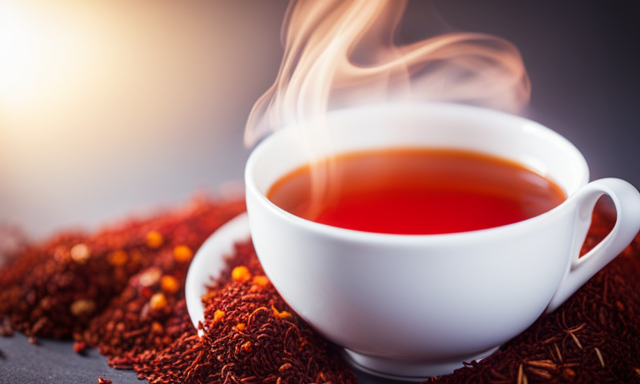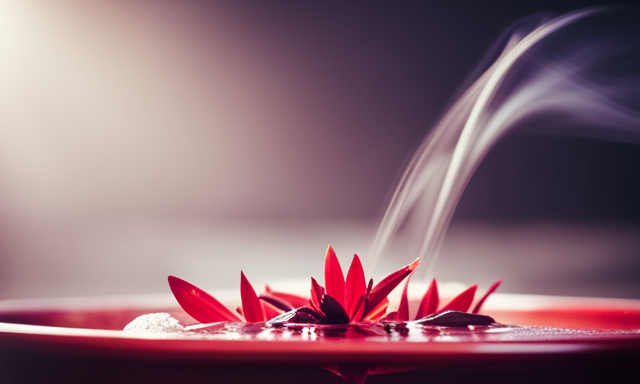As I sit here sipping a warm cup of rooibos tea, I can’t help but marvel at the comforting embrace it offers, like a cozy blanket on a chilly evening. In this article, I will guide you through the delightful world of rooibos tea and help you discover the best varieties that will awaken your taste buds and nourish your body.
Rooibos tea, also known as red bush tea, hails from the majestic mountains of South Africa and boasts a myriad of health benefits. From its rich antioxidants to its soothing properties, this herbal infusion has become a beloved beverage for many.
Join me as we explore the different types of rooibos tea, from the classic red rooibos to the aromatic green rooibos. I will also share tips on how to brew the perfect cup, the various flavor profiles you can expect, and even suggest food pairings to enhance your tea-drinking experience.
So, let’s embark on this tea journey together and uncover the best rooibos tea that suits your preferences and occasions.
Key Takeaways
- Rooibos tea is a caffeine-free alternative to other beverages, making it a healthy and soothing choice.
- There are different types of rooibos tea available, including red rooibos, green rooibos, and flavored options, allowing for a range of flavors and tastes.
- Rooibos tea is known for its high antioxidant content, which can boost the immune system and promote overall well-being.
- Rooibos tea can be enjoyed in various ways, whether hot or cold, and it can be paired with different foods and used in culinary creations to enhance flavors and experiences.
What is Rooibos Tea?
If you’re looking for a tea that’ll warm your soul and invigorate your taste buds, there’s nothing quite like rooibos tea. This South African herbal infusion has gained popularity worldwide for its unique flavor and numerous health benefits.
Rooibos tea is made from the leaves of the Aspalathus linearis plant, which has a long history and origin in the Western Cape region of South Africa. It was traditionally used by the indigenous Khoisan people for its medicinal properties.
Today, rooibos tea is known for its high antioxidant content, which can help boost the immune system and promote overall well-being. Additionally, it’s caffeine-free, making it a great alternative for those looking to reduce their caffeine intake.
So, let’s dive into the next section and explore the health benefits of rooibos tea.
Health Benefits of Rooibos Tea
When you drink this vibrant red herbal infusion, you’ll start experiencing its numerous health benefits such as boosting your immune system and promoting better digestion. Rooibos tea is not only delicious but also packed with antioxidants that help fight off free radicals and reduce the risk of chronic diseases. It is also caffeine-free, making it a perfect choice for those looking to relax and unwind. The health benefits of rooibos tea extend beyond just physical well-being. Its soothing properties can calm the mind, relieve stress, and promote a sense of relaxation. To give you a better idea, take a look at the table below:
| Health Benefits | Description |
|---|---|
| Boosts Immune System | Helps strengthen your body’s natural defense mechanisms |
| Promotes Digestion | Aids in the digestion process and relieves gastrointestinal issues |
As you can see, rooibos tea offers a multitude of health benefits. Now, let’s explore the different types of rooibos tea.
Types of Rooibos Tea
To fully appreciate the variety of rooibos tea options available, you’ll want to explore the different types and flavors.
Rooibos tea comes in several variations, each with its own unique characteristics and health benefits. The most common types include green rooibos, which is unfermented and has a lighter, grassier taste, and red rooibos, which undergoes fermentation and has a rich, earthy flavor. There are also flavored rooibos teas, such as vanilla or citrus-infused options, which add a delightful twist to the traditional taste.
When brewing rooibos tea, it’s important to use boiling water and steep it for at least 5 minutes to fully extract the flavors and health benefits.
Now, let’s delve into the art of brewing rooibos tea and discover the perfect cup.
How to Brew Rooibos Tea
Discover the enchanting process of brewing a warm and invigorating cup of rooibos tea that’ll transport you to a world of relaxation and comfort. Brewing rooibos tea is a simple yet delicate art that requires attention to detail.
To start, bring fresh water to a boil and pour it over the rooibos tea leaves. Allow it to steep for about 5-7 minutes to extract the full flavor and aroma. For a stronger brew, you can extend the steeping time.
As for flavor profiles, rooibos tea offers a variety of options to suit your taste buds. From the earthy and aromatic notes of traditional rooibos to the fruity and vibrant flavors of rooibos blends with citrus or berries, there’s a rooibos tea flavor for everyone.
Now, let’s delve into the fascinating world of flavor profiles of rooibos tea.
Flavor Profiles of Rooibos Tea
When it comes to the flavor profiles of rooibos tea, there are three key points to consider. First, rooibos tea has a naturally sweet and nutty flavor that’s both comforting and delicious.
Second, you can also find fruity and floral notes in certain varieties of rooibos tea, adding a refreshing and aromatic twist to your cup.
Lastly, for those who enjoy a bit of spice and complexity, there are spiced and aromatic blends of rooibos tea available that’ll delight your taste buds.
Overall, the flavor profiles of rooibos tea offer a wide range of options to suit every palate.
Naturally Sweet and Nutty Flavor
Indulge in the rich, naturally sweet and nutty flavor of the best rooibos tea available to experience a truly delightful and satisfying cup. Here’s why this flavor profile will captivate your taste buds:
-
Sweet and Savory Combinations: The naturally sweet and nutty notes of rooibos tea make it the perfect base for exploring unique and delicious sweet and savory combinations. Think of pairing it with dark chocolate or roasted nuts for an indulgent treat.
-
Rooibos Tea Cocktails: Elevate your cocktail game with the rich and nutty flavor of rooibos tea. From a refreshing Rooibos Mojito to a cozy Rooibos Old Fashioned, the possibilities are endless. Sip on these delightful creations and let the flavors take you on a journey.
-
Fruity and Floral Notes: While we delve into the naturally sweet and nutty flavor, it’s important to note that rooibos tea also offers hints of fruity and floral notes. These delicate undertones add complexity and balance to the overall taste, making it a truly delightful experience.
Now, let’s explore the next section, where we’ll uncover the enchanting world of fruity and floral notes in rooibos tea.
Fruity and Floral Notes
Immerse yourself in the enchanting world of rooibos tea as it unveils its hidden treasures of fruity and floral notes, leaving your taste buds mesmerized. Rooibos tea is not only known for its naturally sweet and nutty flavor, but also for its ability to create a delightful combination of floral and herbal infusions. The infusion of fruits and flowers adds a refreshing twist to the tea, with hints of berries, citrus, and delicate florals dancing on your palate. Picture yourself savoring a cup of rooibos tea infused with rose petals and dried apricot, or perhaps a blend of hibiscus and raspberry. These fruity and spicy combinations elevate the rooibos experience to new heights. As we explore further, we will discover the world of spiced and aromatic blends that await us.
Spiced and Aromatic Blends
Get ready to experience a tantalizing journey as you savor spiced and aromatic blends that’ll awaken your senses and leave you craving for more.
When it comes to spiced tea recipes, rooibos tea is a perfect base to experiment with. The warm and comforting flavors of cinnamon, ginger, and cloves blend harmoniously with the earthy notes of rooibos, creating a delightful and invigorating beverage.
Not only do these spiced blends offer a unique and satisfying taste, but they also come with a range of health benefits. The combination of spices in rooibos tea can aid digestion, boost the immune system, and provide anti-inflammatory properties. So, not only will you enjoy the flavors, but you’ll also be doing your body a favor.
Now, let’s delve into the world of popular rooibos tea brands and explore the diverse options available.
Popular Rooibos Tea Brands
Looking for a rooibos tea that’ll make your taste buds do a happy dance? Well, let’s spill the tea on the most popular brands out there!
When it comes to popular rooibos tea brands, there are a few that stand out from the rest. One of the top contenders is Twinings, known for their high-quality and flavorful rooibos blends.
Another crowd favorite is Numi, offering a wide variety of rooibos tea options with unique flavors like vanilla, honeybush, and chai. And let’s not forget about Yogi Tea, who infuses their rooibos blends with a hint of spice and warmth.
These brands not only offer delicious rooibos teas, but also provide the numerous benefits of drinking rooibos tea, such as its antioxidant properties and ability to promote relaxation.
Now that we’ve explored the popular brands, let’s dive into pairing rooibos tea with food.
Pairing Rooibos Tea with Food
Imagine yourself sitting at a cozy cafe, savoring the rich, earthy flavors of a warm cup of rooibos tea as you indulge in a delectable slice of chocolate cake. Pairing rooibos tea with food not only enhances the taste experience but also brings out the best in both the tea and the dish.
Here are five delightful food and tea pairings that will tantalize your taste buds:
- Freshly baked scones with clotted cream and strawberry jam
- Grilled salmon with a honey glaze
- Spicy curry with basmati rice
- Creamy vanilla ice cream with caramel sauce
- Roasted butternut squash soup with a hint of cinnamon
Not only does rooibos tea complement a wide range of flavors, but it also offers numerous health benefits. Packed with antioxidants, it helps boost the immune system and aids in digestion. Its anti-inflammatory properties can reduce the risk of chronic diseases.
Now, let’s explore how rooibos tea can be enjoyed for different occasions.
Rooibos Tea for Different Occasions
When it comes to relaxation and stress relief, Rooibos tea is my go-to beverage. Its soothing and calming properties help me unwind after a long day.
In the mornings, I enjoy a cup of Rooibos tea as my wake-up brew. Its rich and earthy flavor provides a gentle boost of energy to start my day.
And when the weather gets warm, I love preparing refreshing iced tea options with Rooibos tea, incorporating flavors like citrus or berries for a delightful twist.
Relaxation and Stress Relief
For the ultimate relaxation and stress relief, nothing beats sipping on a cup of the best rooibos tea. Rooibos tea is known for its calming properties and is a popular choice for those seeking a moment of tranquility.
When it comes to relaxation techniques and stress management, rooibos tea can be a powerful ally. Here are three reasons why:
- Rooibos tea is caffeine-free, allowing you to unwind without the jitters.
- The tea contains antioxidants that promote relaxation and help reduce stress levels.
- Its natural sweetness provides a soothing taste that can enhance the overall relaxation experience.
Indulging in a cup of rooibos tea is the perfect way to start your day feeling refreshed and rejuvenated. Transitioning into the subsequent section about ‘morning wake-up brews’, rooibos tea can also serve as a gentle and invigorating option to kickstart your mornings.
Morning Wake-Up Brews
Awaken your senses with a steaming cup of invigorating morning brews. For those seeking a caffeine-free alternative to jumpstart their day, rooibos tea is the perfect choice. Its rich, earthy flavor and vibrant red color make it a delightful addition to your morning rituals.
Rooibos tea is known for its numerous health benefits, including its high antioxidant content and ability to boost the immune system. With its naturally sweet taste, it requires no added sugars, making it a guilt-free option for those watching their sugar intake.
Whether enjoyed hot or cold, rooibos tea is a refreshing way to start your day.
Speaking of refreshing, let’s explore the exciting world of iced tea options next.
Refreshing Iced Tea Options
After savoring the invigorating Morning Wake-Up Brews, it’s time to explore the realm of refreshing iced tea options. Rooibos tea lends itself perfectly to creating a thirst-quenching and satisfying iced beverage. With its naturally sweet and nutty flavor, combined with its earthy undertones, rooibos tea provides a unique and refreshing base for a variety of flavor combinations.
Whether you prefer a classic pairing of lemon and mint, or something more adventurous like berries and basil, the possibilities are endless.
To truly enjoy the refreshing qualities of iced rooibos tea, here are five tantalizing options to consider:
-
Citrus Burst: Infuse your rooibos tea with slices of orange, lemon, and lime for a zesty twist.
-
Tropical Paradise: Mix in chunks of pineapple and coconut for an exotic and refreshing taste.
-
Berry Blast: Add a medley of strawberries, blueberries, and raspberries for a burst of fruity goodness.
-
Minty Fresh: Enhance your rooibos tea with fresh mint leaves for a cool and revitalizing flavor.
-
Herbal Delight: Experiment with herbs like basil, lavender, or lemongrass for a delightfully unique infusion.
Now that we’ve explored the world of refreshing iced tea options, let’s move on to where to buy rooibos tea.
Where to Buy Rooibos Tea
If you’re looking to buy rooibos tea, you can easily find it at specialty tea shops or online retailers. Buying online is a convenient option, as you can explore a wide range of brands and flavors without leaving the comfort of your home. Many online retailers offer detailed product descriptions and customer reviews, helping you make an informed decision.
On the other hand, local tea shops provide a more personal experience, allowing you to interact with knowledgeable staff who can guide you in selecting the best rooibos tea for your taste preferences. Whether you choose to buy online or visit a local shop, it’s important to consider factors such as the tea’s origin, quality, and packaging. These considerations will ensure that you’re getting the best rooibos tea for your money.
Now, let’s move on to the next section where I’ll share some tips for storing and enjoying rooibos tea.
Tips for Storing and Enjoying Rooibos Tea
When it comes to storing and enjoying Rooibos tea, there are a few key points to keep in mind. Proper storage is essential to maintaining the freshness and flavor of the tea, so be sure to store it in an airtight container in a cool, dark place.
One of the great things about Rooibos tea is its versatility, so don’t be afraid to experiment with different blends and infusions to find your perfect cup.
Additionally, Rooibos tea can be a wonderful addition to various culinary creations, from baked goods to marinades, so don’t hesitate to explore its potential in the kitchen.
Proper Storage to Maintain Freshness
To ensure your rooibos tea stays fresh and flavorful, the key is proper storage. Maintaining freshness is crucial for preserving the delicate flavors and aromas of this unique tea. Here are some tips on how to store your rooibos tea properly:
-
Keep it airtight: Store your rooibos tea in an airtight container to prevent exposure to air, moisture, and other contaminants that can degrade its quality.
-
Avoid light and heat: Keep your tea away from direct sunlight and heat sources, as they can accelerate oxidation and spoil the tea.
Here is a table that summarizes the proper storage conditions for rooibos tea:
| Storage Condition | Recommendation |
|---|---|
| Container | Airtight container |
| Light exposure | Keep away from direct sunlight |
| Heat exposure | Store in a cool, dry place |
By following these storage guidelines, you can maintain the freshness of your rooibos tea and enjoy its delightful flavors for longer. Now, let’s explore the exciting world of experimenting with blends and infusions.
Experimenting with Blends and Infusions
Get creative and explore the endless possibilities of blending and infusing different flavors to elevate your tea experience.
Rooibos tea is the perfect base for experimenting with blends and infusions, as it’s naturally sweet and nutty flavor complements a wide range of ingredients.
When it comes to blending techniques, you can try mixing different types of rooibos tea together to create unique flavor combinations. For example, combining rooibos with fruity teas like hibiscus or citrus can add a refreshing twist to your brew.
Alternatively, you can infuse your rooibos tea with herbs and spices like lavender, cinnamon, or ginger to create a soothing and aromatic cup.
These blends and infusions can take your tea to the next level, opening up a whole new world of flavors to explore.
Now, let’s dive into the exciting realm of exploring rooibos tea in different culinary creations.
Exploring Rooibos Tea in Different Culinary Creations
Let’s discover the endless culinary possibilities of incorporating rooibos tea into a variety of delicious creations. When it comes to pairing rooibos tea with desserts, the rich and earthy flavors of this South African herbal tea can complement a wide range of sweet treats.
Whether it’s a rooibos-infused chocolate cake, a creamy rooibos panna cotta, or a delicate rooibos macaron, the tea adds a unique depth of flavor that enhances the overall dessert experience.
Additionally, rooibos tea can also be used to create refreshing and innovative cocktails. Its natural sweetness and subtle spiciness make it a great base for cocktails like rooibos mojitos, rooibos margaritas, or even a rooibos-infused gin and tonic.
The possibilities are truly endless when it comes to exploring rooibos tea in culinary creations.
Frequently Asked Questions
Can rooibos tea help with weight loss?
Yes, rooibos tea can help with weight loss. It is known to boost metabolism and has numerous benefits such as aiding digestion and reducing cravings. Incorporating rooibos tea into a healthy lifestyle can support weight management effectively.
Is rooibos tea safe for children to drink?
Rooibos tea is a safe option for children to enjoy, offering numerous benefits. It can help alleviate allergies and provide a range of health benefits. It’s a great alternative to other beverages.
Can rooibos tea help with acne or skin problems?
Rooibos tea has numerous benefits for skincare. It can help with acne and other skin problems due to its anti-inflammatory and antioxidant properties. Regular consumption of rooibos tea can promote healthy, clear skin.
Does rooibos tea contain caffeine?
Rooibos tea is naturally caffeine-free, making it a great alternative to traditional teas. But did you know that it’s also packed with antioxidants that can help improve heart health and boost the immune system?
Are there any potential side effects of drinking rooibos tea?
There are no known side effects of drinking rooibos tea. It is a caffeine-free beverage that offers potential health benefits. It is recommended to consume it in moderation as part of a balanced diet.
Conclusion
In conclusion, after exploring the various types and flavors of rooibos tea, it’s clear that this South African herbal infusion offers a delightful and healthful experience. With its numerous benefits, including its rich antioxidants and soothing properties, rooibos tea is an excellent choice for tea enthusiasts and health-conscious individuals alike.
Did you know that rooibos tea is caffeine-free and doesn’t contain any tannins? This makes it a perfect choice for those seeking a delicious and relaxing beverage without any of the negative side effects.
So go ahead, indulge in a cup of rooibos tea and savor its unique flavors today!










